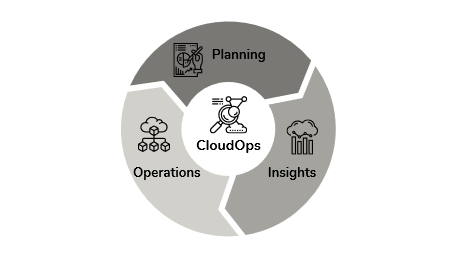CloudOps Overview
Harness the full potential of the cloud with tools that help you optimize cloud operations and cost management.
Overview
CloudOps refers to the process of managing and optimizing IT workloads in the cloud in order to keep essential infrastructure and applications running.
CloudOps combines the functions of cloud architecture, software engineering, security, compliance, and IT operations to provide better accessibility, availability, and business outcomes. Essentially, it's a combination of IT operations and DevOps principles applied to the cloud to help improve and accelerate business processes.
With the help of a solid CloudOps strategy, enterprises can automatically provision virtual machines, perform automatic backup, recovery, and patching activities, and streamline their workflows.
CloudOps is a solution offering designed to help optimize cloud operations and cost management in order to provide enhanced accessibility, availability, flexibility, and efficiency while also boosting business agility. It accomplishes this by reducing cloud expenses through optimized resource utilization, increasing business opportunities through compliance with industry standards and regulations, and improving productivity through workflows that integrate seamlessly with third-party tools.
Some key features and benefits of CloudOps include:
- Tools that help to continuously assess the maturity of operations, gain visibility, and integrate with custom enterprise workflows.
- Cross-cloud standardization, automation, governance, and single-pane-of-glass visibility.
- Rule-based automation for monitoring, alerts and remediation, activity tracking, backup, restore, and patch management.
- Baselining cloud resources to automatically identify drifts and deviations for compliance and governance.
- Extensive support for templates and blueprint scheduling via third-party tool integration.
- Automation and standardization of processes that help to minimize human dependency and eliminate manual errors that impact service availability and performance.
Getting started with CoreStack:If this is your first time using CoreStack, there are some first steps you should take before diving deeper into CloudOps. Please make sure to read our Getting Started user guide to get help setting up your CoreStack account.
Understand the CloudOps lifecycle
The CloudOps product is built around a CloudOps lifecycle we developed using established best practices. This lifecycle is comprised of three phases, illustrated in the graphic below.

The CloudOps framework flywheel
The core functionality of the CloudOps product offering is designed to align to the main phases of this lifecycle: Planning, Insights, and Operations. By repeating the steps you take through the CloudOps lifecycle, you start to get a “flywheel effect,” which allows you to iterate faster and mature as you move through the crawl, walk, and run stages.
CloudOps lifecycle phases:Planning phase: Create cloud governance requirements for various activities and alerts, such as types of workloads and their resource needs, as well as security.
Insights phase: Use insights and fine-tune parameters to manage cloud resources by acquiring visibility into cloud activity and monitoring alerts. Metric and anomaly insights should also be made available at this stage.
Operations phase: Ensure you have smooth CloudOps processes with the help of automation, alerts, and notifications. This also includes leveraging workflows with third-party ITSM tools.
Now that you have a better understanding of CoreStack CloudOps and the CloudOps lifecycle, you're ready to get started with this solution offering.
Use the links and references below to learn more about the key features of CoreStack CloudOps and walk through the steps needed to optimize your cloud operations and drive business efficiency.
Get started with CoreStack CloudOps
Gain visibility and insights
- Gain real-time visibility through operations posture
- Create and view operations reports
- Detect operational anomalies
- Create executive dashboards (coming soon!)
- Take a CloudOps maturity assessment (coming soon!)
Optimize your cloud operations
- Provision cloud resources through templates
- Automate key processes and actions with scripts
- Automate tasks across multiple cloud resources with blueprints
- Setup and manage activity notifications
- Setup monitoring and alerts
Setup and manage administration
Updated about 2 months ago